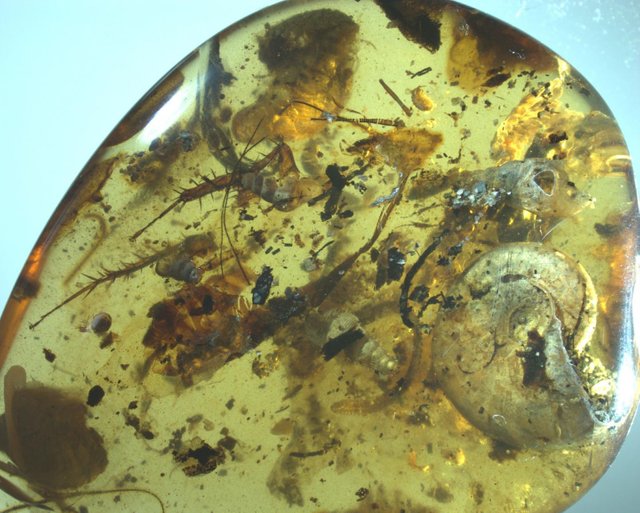99 million years ago, an ammonite washed ashore and became encased in amber

Amber piece showing most large inclusions . CREDIT: NIGPAS USAGE RESTRICTIONS: None
Organisms trapped in amber and preserved for millions of years is not a new phenomenon. Folks have been remarking on it for millennia, admiring and wondering about the animals and plants and where they came from. Animals trapped in amber were even a major plot point for the book of Jurassic Park and its subsequent sequels, both written and filmed.
Amber is fossilized tree sap. Tree sap is very sticky and this is how animals and plants get entangled and then preserved. Most of the time, the organisms entrapped are terrestrial, meaning they live on land. That makes a certain amount of sense. Trees are land organisms and the source of sap. Occasionally though, through extraordinary circumstances, marine organisms, sea creatures, are encased.
Myanmar, or Burma has it has been called in the past, has been produced an absolute treasure trove of amber preserved fossils. Feathered dinosaur tails have come to light. An extinct, beakless lineage of bird had a hatchling preserved. There has been more. All of which have come from the Cretaceous and specifically the Cenomanian stage. Myanmar has produced yet another extraordinary amber fossil. This time with marine organisms.
That is a very rare event, as noted, but it is extremely rare for the Cretaceous. That alone would have made this a really exciting find. However, what makes it an amazing find above and beyond that is there is a spiral shell in the amber. It was thought to be a snail at first. However, it was not. In what may be a first in the world, the spiral shell is from an ammonite.
Ammonites were an extinct cephalopod lineage, types of mollusks related to squids, octopi and snails. They were extremely common in the Mesozoic seas and were wiped out at the end of the Cretaceous with the KT or K-Pg Mass Extinction. They are reminiscent of the nautilus, the sole shelled octopus or squid relative still alive in our oceans today. There have been wonderful fossils of them in stone and they are extremely useful for biostratigraphy, or the use of fossils to determine the age of marine sediments from prior to the extinction of the dinosaurs. They ranged from giant to very small. A very small one, somehow washed ashore and got stuck in tree sap, becoming preserved for the last 99 million years.
This piece of Burmese amber may be the first example of an ammonite so exquisitely preserved. If the preservation is very good like in the scenario where the ammonite was encased immediately after being washed ashore, it may be possible to learn details that have eluded paleontologists about these long extinct and once ubiquitous animals.
An ammonite trapped in Burmese amber
https://www.pnas.org/content/early/2019/05/09/1821292116.short
Coastal organisms trapped in 99-million-year-old amber
https://www.eurekalert.org/pub_releases/2019-05/caos-cot050919.php
Ammonoidea
https://en.wikipedia.org/wiki/Ammonoidea
Cephalopod
https://en.wikipedia.org/wiki/Cephalopod
Biostratigraphy
https://en.wikipedia.org/wiki/Biostratigraphy
Wow, I really enjoyed reading this.
thank you!